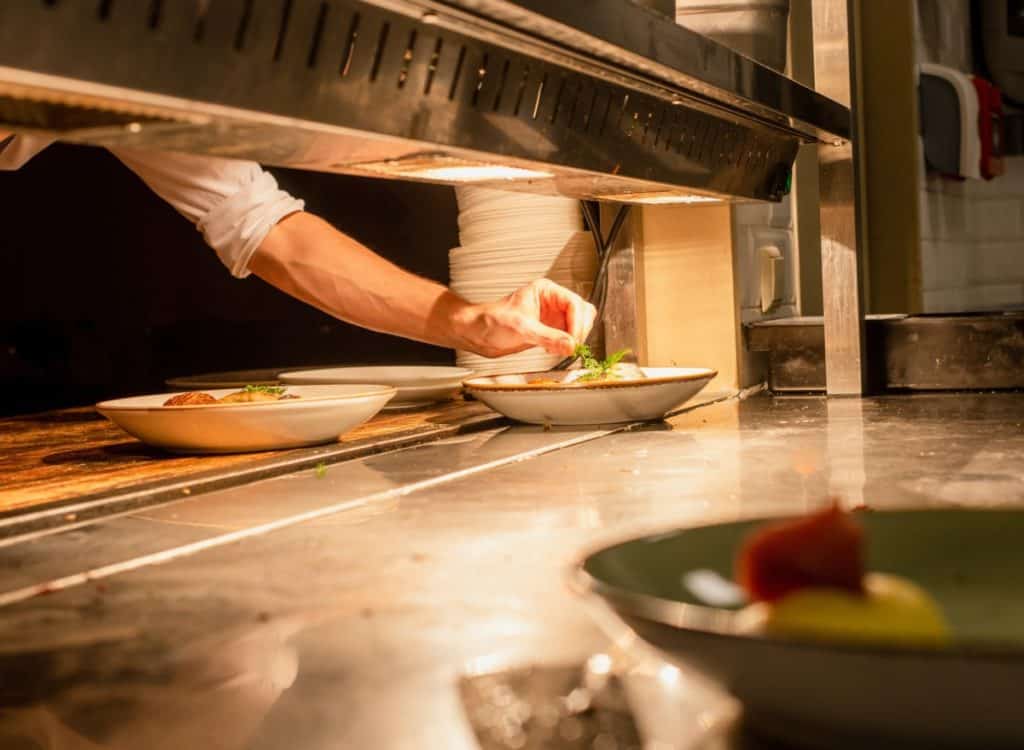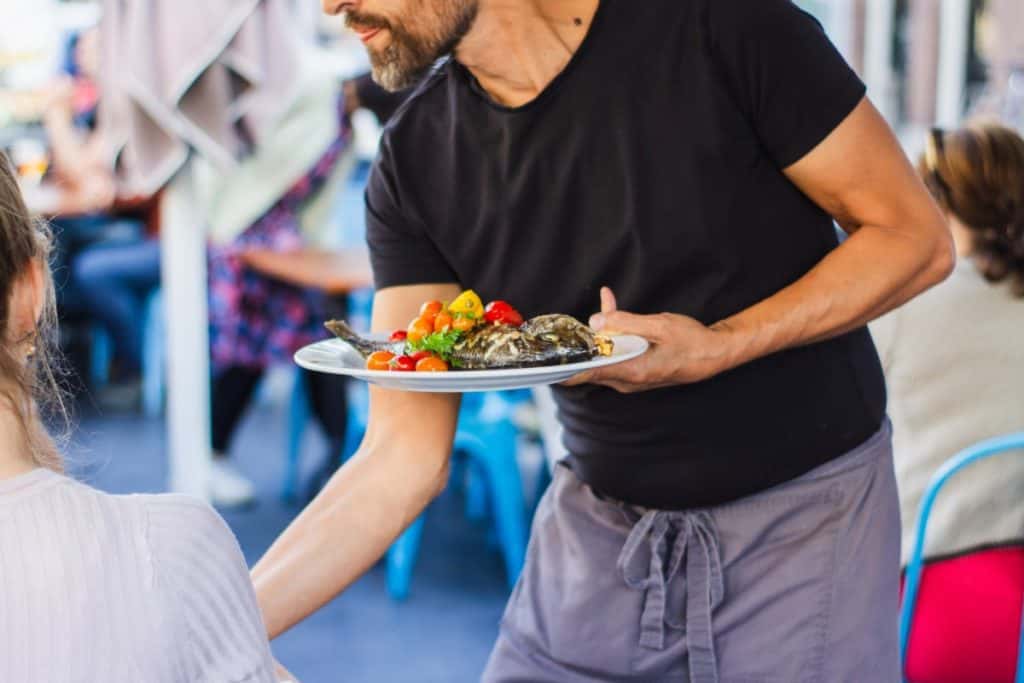
Looking in from the outside it may seem like a kitchen during a lunch or dinner service is absolute chaos! There’s shouting and banging, chefs moving quickly, as well as a line of stressed out looking waiting staff. But is being a chef as chaotic as it seems?
Whilst a kitchen service is definitely busy and often stressful, there is an organised system in place to make sure everything runs smoothly (most of the time anyway!)
In this article I will explain in detail the flow of a restaurant service from the moment the order enters the kitchen to the point where the customers have paid and are enjoying their evening coffees.
A professional kitchen operates by the head chef standing at the front of the kitchen (called the pass) and organising everything around them. Much the same as a conductor controls an orchestra, it is the head chef’s responsibility to control the kitchen and keep the other chefs in time.
So how does the Head Chef achieve this kitchen control? I have broken the flow of service down using the sub headings below. This will take the reader through each stage of an evening meal for a table of two customers.
achieve this kitchen control? I have broken the flow of service down using the sub headings below. This will take the reader through each stage of an evening meal for a table of two customers.
By breaking it down into one table, I hope that readers can get an idea of the kitchen system that is used, then simply multiply it by the number of tables to get an idea of why a kitchen service can get very busy indeed!
Waiter Collects the Amuse-Bouche
The amuse-bouche is the term for the little free ‘nibbles’ that restaurants provide. It can be as simple as some bread with olives up to intricate bite sized portions of cuisine.
is the term for the little free ‘nibbles’ that restaurants provide. It can be as simple as some bread with olives up to intricate bite sized portions of cuisine.
This free ‘nibble’ food serves two purposes.
- Firstly, It makes the customer happy to have some free food.
- Secondly, As the waiter collects the food, they will inform the head chef that their table has been seated. This is important information as customers are rarely on time and it helps to gauge when that table’s order will arrive.
Head Chef Calls Out The Order
The waiter will bring their table’s order into the kitchen and hand it to the Head Chef. It is impossible for all the other chefs to see the order for themselves as they are busy cooking by the stoves. Therefor the head chef will call this order out to the kitchen.
They will start by saying ‘check on’, here’s an example below;
- ‘Check on, Starters: 1 mussels, 1 soup, Mains: 1 fillet steak – medium, 1 salmon’
‘Check On’ is the phrase used to let the chefs know this is an order that has just come in and one they need to prepare. We’ll see why this phrase is important later!
Chefs Will Listen To Order And Respond
This is where the famous ‘yes chef’ call comes into play. The chef on each section will be listening out to hear if anything on the order needs to come from their section of the kitchen, if it does they need to acknowledge that they have heard it.
For example the chef responsible for soup will respond ‘yes chef’ or ‘Oui chef ‘ to signal they have heard the order and begin to prepare the soup. The chef’s responsible for the main dishes will also respond and make a mental note they have a main to cook.
‘ to signal they have heard the order and begin to prepare the soup. The chef’s responsible for the main dishes will also respond and make a mental note they have a main to cook.
Most chefs have a system for ensuring they don’t forget about an order. Here’s an example:
- The chef responsible for the fillet of beef
 will not want to start cooking it yet as it will be overdone by the time it is ready to be served. A common method is to place a portion of fillet onto the chopping board and season it. This lets the chef know, with a simple glance at their chopping board
will not want to start cooking it yet as it will be overdone by the time it is ready to be served. A common method is to place a portion of fillet onto the chopping board and season it. This lets the chef know, with a simple glance at their chopping board , how many orders they have on.
, how many orders they have on.
A method I always used
was to place the steak at a different point on the chopping board depending on how it needed to be cooked. Any steaks at the top of the board I knew where orders that needed to be cooked ‘well done’. Then placing steaks going down the board to the ones at the bottom, that I knew needed to be cooked ‘rare’. A simple but effective system!
The Waiter Will Ask For Their Customer’s Starters
If not enough time has passed between the order coming into the kitchen and the waiter asking for their table’s starters, the Head chef will inform them they need to wait a few minutes. If the Head chef feels enough time has passed they will call the starters ‘Away’
This means they will shout to the kitchen ‘Away’ followed by the order. As our example:
- ‘Away: 1 mussels, 1 Soup’
The chefs which are responsible for these dishes will reply ‘yes chef’ to acknowledge they have heard the instruction and begin taking the food up to the pass to be plated.
When the order is called ‘away’ a chef needs to have that order close to being finished. This is not always the case and may result in some serious rushing around!
Everyone needs to bring their elements of the dish up to the pass at the same time for the head chef to plate up. A sure fire way to upset a head chef is to delay a whole order because your element is not ready!
A lot of the pressure in kitchens
come from the fact that there is a small window when the food is perfect before it starts to go cold or overcook. If a table sits at the pass going cold waiting for one of the chefs to be ready with their element of the order. There’s a good chance the Head chef is going to scrap all the food and ask for it all to be re cooked!
Assuming everything goes to plan the waiter will take the food out to their (hopefully happy) customers.
will take the food out to their (hopefully happy) customers.

The Waiter Will Ask For The Main Courses
Once the customers have finished their starters, their empty plates will be cleared and the waiter will let the Head chef know that their table is ready for their main course.
This will cause the Head Chef to call the mains ‘away’ to the kitchen similar to the way they called for the starters. For example:
- ‘Away: 1 fillet of beef – medium, 1 salmon’
Every chef responsible for an element of these dishes will respond ‘yes chef’. As before, they are acknowledging they have heard the order and are getting it ready.
The chefs will often need to communicate among themselves at this point. For example the chef on veg section will ask the chef on meat section how long until their fillet is ready. This lets the veg chef prepare their veg so all the elements arrive at the pass at the same time.
will ask the chef on meat section how long until their fillet is ready. This lets the veg chef prepare their veg so all the elements arrive at the pass at the same time.
There is a definite kitchen hierarchy among the different sections. The meat section is typically highest and they will dictate the pace. The veg chef will need to work to the meat chefs timings, not the other way around!
among the different sections. The meat section is typically highest and they will dictate the pace. The veg chef will need to work to the meat chefs timings, not the other way around!
One of the most heart breaking things that can happen during a service is to hear a check called ‘away’ for something that you didn’t even realise was ‘on’ (perhaps you didn’t hear the ‘check on’ call)
Sometimes you would be fortunate and could quickly prepare the dish (a steak cooked rare for example), other times you find yourself in big trouble ( a steak cooked well done for example). There is no possibility of cooking the well done steak in time and you have to be honest with the Head Chef and tell them you missed the order and it isn’t ready.
Some chefs are laid back and understanding. Others not so much!
A missed order for a ‘well done’ steak is perhaps the gold standard of mistakes! The time it takes to cook the steak from scratch is time that the customers are sat there in between courses, twiddling their thumbs waiting.
Assuming everything goes to plan the Head chef will plate the main courses, hand it to the waiter who will deliver them to the customer.
Once the mains leave the kitchen the order ticket is pushed onto the spike by the Head Chef so they know that order is complete and done!
What Happens If A Meal Is Returned To The Kitchen?
If for any reason the meal is returned to the kitchen (perhaps the steak isn’t done to the customers liking) all priorities shift to getting a replacement meal out of the kitchen as quickly as possible. Some kitchens, especially higher end ones, will replace both the customers dishes. This prevents one customer sitting with their meal in front of them going cold whilst they wait for their partners dish to be re-cooked.
As a chef, this can be difficult to juggle as you suddenly have extra work to do on top of the constant flow of regular orders coming in.
It’s the sign of a great restaurant that handles customers complaints swiftly and resolves the issue so the customer is completely satisfied.
The Waiter Clears The Mains And Takes The Dessert Order
At this point everything should have gone well. The customers have hopefully enjoyed their meal and as the waiter clears their empty plates he presents them with the dessert menu.
The waiter then returns to take their dessert choices and brings that order into the kitchen.
At this point different kitchens operate in different ways.
- Some Head Chefs will receive this dessert order. As with the mains they will call it out to the kitchen for the chefs responsible for desserts to respond.
- More commonly in my experience, the order is given to the Head Pastry Chef to call out to their chefs, or placed on the ticket rail for all the pastry chefs to see.
This second method is possible because the dessert section is usually smaller and everyone has the opportunity to read the ticket for themselves. Also as the main service is still on going, instead of the Head Chef calling out a ticket which is irrelevant to most of the chefs, and adding to the noise, it is beneficial to have a separate Head Pastry chef to take care of it.
is still on going, instead of the Head Chef calling out a ticket which is irrelevant to most of the chefs, and adding to the noise, it is beneficial to have a separate Head Pastry chef to take care of it.
How Does The Pastry Section Work?
The pastry sections’ service is different from the main kitchen because the timings are generally less important. Once a customer has ordered a dessert they are usually ready to eat it as soon as it is available.
When the dessert order comes into the kitchen it is placed into the queue. The pastry chefs work their way along the queue sending each order out to the customer as it is ready.
In our example table they ordered: 1 cheesecake and 1 mousse.
- As these are both cold they can begin to be prepared as soon as the order comes in. Both dishes can sit for a little while in the cool of the pastry kitchen without spoiling until the customer is ready.
It is this extra time that allows the pastry chefs to produce some amazing works of art on the plates.
Hot desserts will need to be plated to order. Again the pastry section operates as its own independent kitchen and will communicate timings among themselves.
On a personal note I always enjoyed the pastry section due to the extra time available to make the presentation eye-catching. Another bonus is that not every customer has a dessert so the overall covers can be less than the main kitchen.
A downside of the pastry section is that you are the last chefs to leave, as desert orders can stretch late into the night!
The Waiter Will Deliver The Customers Their Desserts
Once they are ready, the waiter will take the desserts to the customers, hopefully to be met with lots of ‘oohs and ahhs’
Any coffees or evening drinks should be served to the customers at this point, and if everything has gone correctly, our example couple will have enjoyed a wonderful meal out that they go on to tell all their friends and co workers about.
To Sum Up
That’s a complete order flow from start to finish. It’s worth remembering that this example is for just one table.
During a busy service with lots of customers, a chef has to juggle multiple orders at the same time, with orders coming in and leaving the kitchen at the same time. This is why the ‘check on’ and ‘away’ calls are so important.
Each chef has their own system for remembering which orders they have on (similar to my system demonstrated above for the steak orders) A chef can also increase the quantity for multiple orders. For example, If a chef has multiple soup orders on, it makes sense to heat up a few portions at the same time.
for remembering which orders they have on (similar to my system demonstrated above for the steak orders) A chef can also increase the quantity for multiple orders. For example, If a chef has multiple soup orders on, it makes sense to heat up a few portions at the same time.
This has hopefully given readers a greater insight into the method behind the madness of a kitchen service so that it may not be so intimidating if starting a career!
